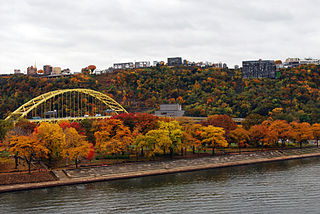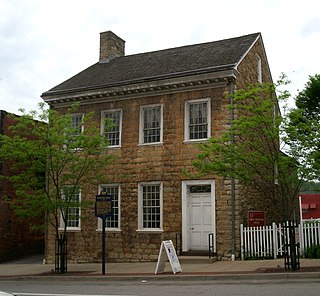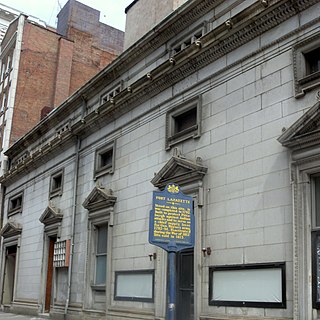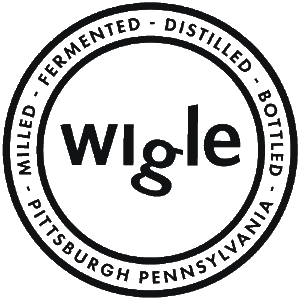
Allegheny County is a county in the southwest of the U.S. state of Pennsylvania. As of 2017 the population was 1,223,048, making it the state's second-most populous county, following Philadelphia County. The county seat is Pittsburgh. Allegheny County is included in the Pittsburgh, PA Metropolitan Statistical Area, and in the Pittsburgh Designated Market Area.

Bozeman is a city in and the seat of Gallatin County, Montana, United States. Located in southwest Montana, the 2010 census put Bozeman's population at 37,280 and by 2016 the population rose to 45,250, making it the fourth largest city in Montana. It is the principal city of the Bozeman, MT Micropolitan Statistical Area, consisting of all of Gallatin County with a population of 97,304. It is the largest Micropolitan Statistical Area in Montana and is the third largest of all of Montana's statistical areas.

North Braddock is a borough in Allegheny County, Pennsylvania, United States. North Braddock was organized from a part of Braddock Township in 1897. The borough prides itself in being the "Birth Place of Steel" as the home of Andrew Carnegie's Edgar Thomson Steel Works that opened in 1875. North Braddock is a suburb 11 miles (18 km) east of Pittsburgh with a 15-minute travel time to the city. The borough is located in the valley along the Monongahela River, and is made up of three jurisdictional voting wards.

Greensboro is a borough in Greene County, Pennsylvania, United States. The population was 260 at the 2010 census, down from 295 at the 2000 census.

Downtown Pittsburgh, colloquially referred to as the Golden Triangle, and officially the Central Business District, is the urban downtown center of Pittsburgh. It is located at the confluence of the Allegheny River and the Monongahela River whose joining forms the Ohio River. The "triangle" is bounded by the two rivers. The area features offices for major corporations such as PNC Bank, U.S. Steel, PPG, Bank of New York Mellon, Heinz, Federated Investors and Alcoa. It is where the fortunes of such industrial barons as Andrew Carnegie, Henry Clay Frick, Henry J. Heinz, Andrew Mellon and George Westinghouse were made. It contains the site where the French fort, Fort Duquesne, once stood.

Point State Park is a Pennsylvania state park on 36 acres (150,000 m2) in Downtown Pittsburgh, Allegheny County, Pennsylvania, USA, at the confluence of the Allegheny and Monongahela rivers, forming the Ohio River.
David Bradford (1762–1808) was a successful lawyer and deputy attorney-general for Washington County, Pennsylvania in the late 18th century. He was infamous for his association with the Whiskey Rebellion, and his fictionalized escape to the Spanish-owned territory of West Florida with soldiers at his tail. He was later pardoned by President John Adams for his actions. Today, his family's home in Washington, Pennsylvania is a national landmark and museum.

Pennsylvania Route 88 is a 68-mile-long (109 km) north–south state highway located in southwestern Pennsylvania. The southern terminus of the route is at U.S. Route 119 (US 119) in Point Marion less than 2 miles (3 km) from the Pennsylvania-West Virginia border. The northern terminus is at PA 51 in Pittsburgh. PA 88 runs parallel to the Monongahela River for almost its entire length.

Braddock's Field is a historic battlefield on the banks of the Monongahela River, at Braddock, Pennsylvania, near the junction of Turtle Creek, about nine miles southeast of the "Forks of the Ohio" in Pittsburgh, Pennsylvania. Here, in 1755, was fought the Battle of the Monongahela which ended the Braddock Expedition.

Fort Pitt Museum is an indoor/outdoor museum that is administered by the Senator John Heinz History Center in downtown Pittsburgh, Allegheny County, Pennsylvania in the United States. It is at the confluence of the Monongahela and Allegheny Rivers, where the Ohio River is formed. Fort Pitt Museum is surrounded by Point State Park, a Pennsylvania state park named for the geographically and historically significant point that is between the rivers. This piece of land was key to controlling the upper reaches of the Ohio River Valley and western Pennsylvania, before, during and after the French and Indian War as well as the American Revolution.

The David Bradford House is a historic house museum at 175 South Main Street in Washington, Pennsylvania. Completed in 1788, it was the home of David Bradford, a leader of the Whiskey Rebellion. It has both architectural and historic importance, and was designated a National Historic Landmark in 1983. It is open weekly between April and November, or by appointment.

Three Rivers Park is a public urban waterfront park along the Allegheny, Monongahela, and Ohio Rivers in Pittsburgh, Pennsylvania.

Fort Lafayette, later renamed Fort Fayette, (1792–1814) was an American colonial fort in Pittsburgh, Pennsylvania, United States. It was constructed in June, 1792 by Major General Anthony Wayne upon his commission to form the Legion of the United States.
John Ormsby (1720–1805) was a soldier in the French and Indian War, Pontiac's Rebellion, and the American Revolution, and among the first settlers of Pittsburgh, Pennsylvania. The son of the Anglo-Irish landed gentry, he emigrated from Ireland to the Thirteen Colonies in 1752. After Pontiac's Rebellion, he received a land grant from King George III, and established a homestead on the banks of the Monongahela River. He established extensive economic and merchant interests in Bedford, Pennsylvania, and at the head of the Ohio River.

The 1948 Donora smog was a historic smog event that killed 20 people and caused respiratory problems for 6,000 people of the 14,000 population of Donora, Pennsylvania, a mill town on the Monongahela River 24 miles (39 km) southeast of Pittsburgh. The event is commemorated by the Donora Smog Museum.

The Albert Gallatin Memorial Bridge was a cantilever truss bridge that carried vehicular traffic across the Monongahela River in the southwestern part of the U.S. state of Pennsylvania. Built in 1930 to replace a ferry, it connected Point Marion in Fayette County and Dunkard Township in Greene County. It was named in honor of U.S. Senator, and longtime U.S. Treasury Secretary and diplomat Albert Gallatin, whose Friendship Hill homestead is nearby.

Wigle Whiskey is an artisan small batch whiskey distillery in the Strip District neighborhood of Pittsburgh. Wigle Whiskeys are the flagship products of the Pittsburgh Distilling Company, LLC, which is entirely family owned and operated.
The following is a timeline of the history of the city of Pittsburgh, Pennsylvania, US.























